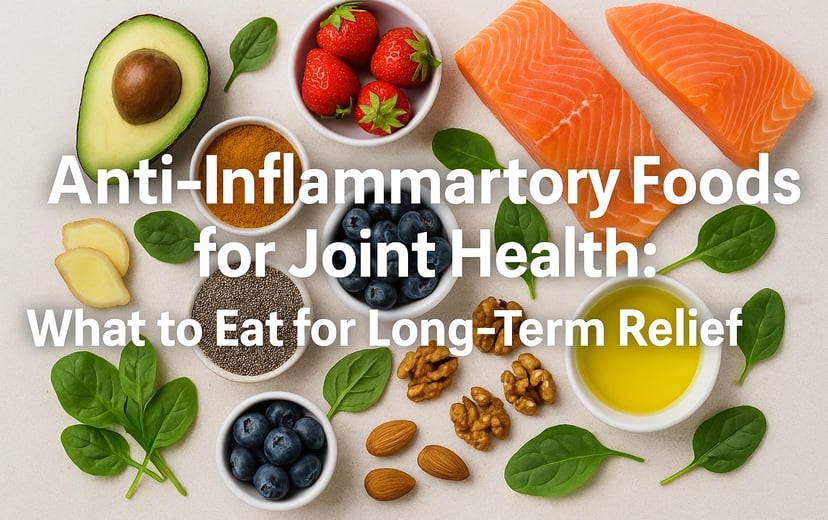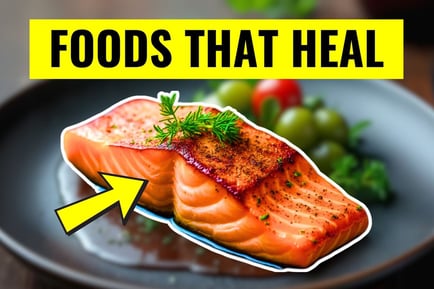The Best Anti-Inflammatory Foods for Joint Health (Backed by Science)
Discover the top anti-inflammatory foods that support joint health, reduce pain, and fight stiffness—backed by clinical studies and expert insights. Eat smarter to move better, longer.
6/3/20254 min read


Anti-Inflammatory Foods for Joint Health: What to Eat to Stay Mobile, Strong, and Pain-Free
Chronic joint pain isn’t just an issue for older adults or elite athletes—it’s becoming more common in everyday people due to rising levels of inflammation driven by diet, stress, and inactivity. If your knees ache after a workout, your hips feel stiff in the morning, or your hands throb by the end of the day, you’re not alone—and it might be time to look at your plate.
The good news? Food can be part of the solution. Certain ingredients can naturally lower inflammation, strengthen joint tissue, and support long-term mobility. This article covers the most powerful anti-inflammatory foods for joint health—backed by real science—and how to use them daily.
- What Is Inflammation and Why It Wrecks Your Joints
Inflammation is your body’s natural defense mechanism. Short-term (acute) inflammation is helpful for healing injuries, but long-term (chronic) inflammation wears down cartilage, damages joint linings, and triggers pain. Over time, this can lead to conditions like osteoarthritis and rheumatoid arthritis—even in people without major injuries.
A 2021 review in Frontiers in Immunology explained how chronic low-grade inflammation is a key driver of joint degeneration, making diet a powerful tool for prevention. Certain foods can either fuel or fight this inflammation. Let’s focus on the ones that do the latter.
-Fatty Fish: Omega-3s That Cool Inflammation
Fatty fish like salmon, sardines, and mackerel are among the most effective anti-inflammatory foods on the planet. They’re rich in EPA and DHA—two omega-3 fatty acids that reduce the production of inflammatory proteins like cytokines and prostaglandins.
In a controlled study published in Annals of the Rheumatic Diseases, people with rheumatoid arthritis who took daily omega-3s had significantly less joint pain and stiffness. Even if you can’t eat fish multiple times a week, taking a clean, high-potency omega-3 supplement can still help reduce inflammation systemically.
-Leafy Greens: Dense in Micronutrients That Protect Joints
Dark leafy greens like spinach, kale, and Swiss chard are rich in vitamins C and K, calcium, magnesium, and plant antioxidants—all critical for preserving joint health. Vitamin C helps with collagen production, which maintains joint structure. Vitamin K regulates calcium placement, preventing buildup in the wrong areas (like cartilage).
These greens also contain plant polyphenols that suppress inflammation at the cellular level. And because they’re high in fiber, they support a healthy gut microbiome—which has a massive impact on your body’s overall inflammation.
To get more greens in when life gets busy, try adding a scoop of freeze-dried organic greens powder to smoothies or water.
-Berries: Antioxidants That Neutralize Joint Stress
Blueberries, strawberries, blackberries, and raspberries are packed with anthocyanins—natural compounds that reduce oxidative stress and fight inflammation. These compounds help protect joint tissues from wear and tear while also reducing stiffness.
According to a 2020 review in Advances in Nutrition, regular berry intake was linked to significant reductions in CRP (C-reactive protein) and other inflammatory markers. Berries are especially helpful post-workout, when oxidative stress is at its peak.
Pair them with a protein like Greek yogurt and a tablespoon of chia seeds for a blood sugar-stable breakfast that doubles as joint therapy.
-Healthy Fats: Olive Oil, Avocado, Nuts & Seeds
Not all fats are created equal. Refined seed oils promote inflammation, while healthy fats actively reduce it. The standout? Extra virgin olive oil.
Olive oil contains oleocanthal, a compound that works similarly to ibuprofen by blocking enzymes that trigger inflammation. One study published in Nature even called it a “natural anti-inflammatory drug.” Cooking with cold-pressed extra virgin olive oil daily adds anti-inflammatory power to your meals without any extra effort.
Other joint-friendly fats include avocado (rich in monounsaturated fats), walnuts (which contain ALA, a plant-based omega-3), and flaxseeds. Just a handful a day of these nutrient-dense fats can have measurable effects on joint stiffness and swelling.
-Turmeric and Ginger: Nature’s Natural Pain Relievers
Turmeric’s active compound, curcumin, is one of the most studied anti-inflammatories in the world. It targets multiple inflammatory pathways, including NF-kB, a molecule that activates genes linked to pain and swelling. Several human studies have shown that curcumin reduces joint pain and improves mobility in people with arthritis.
The key is bioavailability—curcumin needs black pepper or fat to absorb well. Stirring a teaspoon of organic turmeric powder into warm milk or a smoothie is a great way to use it regularly.
Ginger, similarly, contains gingerol compounds that fight inflammation and soothe sore joints. Drinking fresh ginger tea or using a ginger root supplement daily may help reduce pain without the side effects of NSAIDs.
-Whole Grains and Legumes: Fiber That Regulates Inflammation
Low-fiber diets are linked to higher levels of inflammatory markers like CRP and interleukin-6. That’s where whole grains and legumes come in. Oats, quinoa, brown rice, barley, lentils, and chickpeas are packed with fiber, iron, magnesium, and B vitamins that support long-term joint resilience.
Their high fiber content also stabilizes blood sugar, which reduces inflammatory spikes. Try building your lunch around pre-cooked microwavable quinoa packs and canned beans—it’s fast, filling, and incredibly effective for inflammation control.
-The Foods You Shouldn’t Eat for Joint Health
Knowing what to avoid is just as critical. Inflammatory foods can undo the benefits of all the healthy meals you’re adding.
Watch out for:
Refined sugar – found in snacks, sauces, cereals, and drinks. It spikes insulin and contributes to joint damage.
Processed meats – bacon, sausage, and deli meats contain advanced glycation end products (AGEs) that inflame tissues.
White carbs – like white bread, rice, and pastries that fuel systemic inflammation.
Trans fats – still present in some packaged and fried foods despite being banned in many places.
These ingredients don’t just promote inflammation—they also deplete antioxidants and overwhelm your body’s healing systems. If your joints hurt, cutting these out can give your body space to recover.
-Final Take: Food That Fights for You
This isn’t about a 30-day detox or hopping on the latest superfood trend. Protecting your joints is about consistency. When you nourish your body with foods that reduce inflammation daily, you’re not just managing pain—you’re actively rebuilding tissue, supporting recovery, and preserving mobility for years to come.
Focus on:
Eating fatty fish or taking a daily omega-3
Cooking with olive oil
Adding berries and chia seeds to your breakfast
Using turmeric and ginger root in your routine
Building meals with grains and legumes for fiber and joint support
If you can do those things 80% of the time, your joints won’t just feel better—they’ll function better. You’ll move with more freedom, bounce back faster, and stay in the game longer, no matter your age.
Here are two videos i would recommend you check out!!
FITNESS
Nutrition
WellnesS
info@movebetterco.com
© 2025. All rights reserved | Privacy Policy | Terms & Conditions



